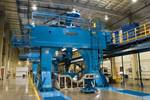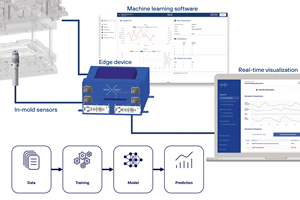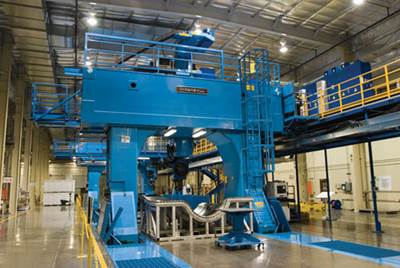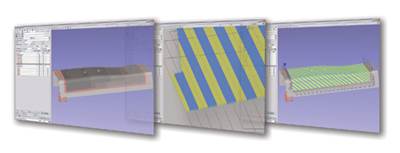Status update on composites automation
Consultant Carroll Grant reviews progress made in recent years toward greater variety in automated composites processing machine sizes configurations and capabilities.
In 2004, I wrote a “Speaking Out” article for HPC, offering my perspectives on the aerospace industry’s need to reduce the cost of composite parts through the use of automated processing equipment. My article focused specifically on the need for a greater variety of composites processing machine sizes and configurations. I also recommended that machine suppliers develop more affordable machines that would give more parts manufacturers access to high-tech automated processing methods.
In the past seven years, some progress has been made. Suppliers of composites processing equipment are offering a greater variety of machines and have made significant improvements to automated tape laying (ATL) and automated fiber placement (AFP) technologies.
Fiber placement equipment now is offered in four configurations: a conventional winding-style machine platform, a gantry platform, a traveling-column platform and a small machine based on an articulated robotic arm.
AFP delivery-head technology also has improved. The latest head technologies, developed for fabrication of very large composite structures, run wider slit-tape materials and, therefore, have much better output rates (lb/hr) than previous AFP systems. The new AFP delivery heads can place slit tapes in widths that range from 0.250 inch to 0.500 inch, instead of the narrow 0.125-inch materials that typically were used for many years with AFP.
In the past few years, several new fiber placement delivery-head technologies also have been developed. Two machine suppliers, Ingersoll Machine Tool (Rockford, Ill.) and Electroimpact (Mukilteo, Wash.), offer AFP delivery heads with the material spools (creel) mounted on the head. Mounting the creel on the delivery head shortens the path that material must travel from the spool to the cut, clamp and restart (CCR) mechanism in the head. The shorter material path simplifies the process and reduces the risk of process interruptions. Electroimpact and Ingersoll also offer a “quick change” capability for changing out material-delivery heads.
MAG IAS (formerly Cincinnati Machine, Hebron, Ky.) offers a wider range of AFP machines than in previous years. MAG has four sizes of AFP machines and recently started offering a gantry AFP machine. The latest MAG AFP machines have improved bidirectional lay-up capability, programmable compaction force and infrared heating, all of which improve processing speed.
Over the years, one of the few negatives about fiber placement has been the perception that it is a slow process. Fiber placement was usually sold based on its ability to lay material on complex shapes and not so much for its speed and output capabilities. But improved processing speed has been an objective for all the AFP machine suppliers.
MTorres (Torres de Elorz, Navarra, Spain) has developed new AFP delivery-head technology that has significantly advanced processing speed. The head technology developed by MTorres is based on the company’s 35-year history as a supplier of processing equipment for the paper industry. The cutting and splicing technology used for its paper-industry equipment was determined to be applicable to the composites automation industry and influenced the company’s decision to develop composites processing equipment.
The CCR mechanism developed by MTorres is based on a rotary process for material cuts and adds during processing. The rotary cutter and refeed rollers match the speed of the material traveling through the delivery head and enable cut-and-add of slit tape materials at maximum machine speeds. The rotary CCR process also can perform cuts and refeeds with close-tolerance accuracy, even at full machine speeds.
MTorres also borrowed technology from its paper equipment to develop an automated slit-tape splicing system. The machine creel contains primary and secondary spool stations. When the primary spool’s tape runs out, the tape from the secondary spool is automatically spliced onto the primary spool’s material end while fiber placement continues uninterrupted.
The automated tape laying process also is alive and well, and the suppliers of these machines offer new-generation equipment. MAG, MTorres and Forest-Liné (Capdenac, France) are offering ATL systems with improved output rates. MAG also offers a new small, flat ATL system, with a fixed-bed gantry configuration, designed specifically for laying flat laminates that subsequently will be hot formed to the final part shape.
Forest-Liné has made major improvements in the output rates of its ATL machines. The company’s latest ATL, the V2, has a redesigned head that is more compact. Its offline cutting system, used to prepare tape courses for its “two-phase” and “dual-phase” ATL processes, has been simplified. Forest-Liné claims the output rates of its latest ATL machines are double those of its earlier ATL models.
MTorres offers a variety of ATL machine configurations (gantry and moving column) and tape delivery heads. The moving column configuration is intended to lay up material on cylindrically shaped tools. MTorres also offers ATL delivery heads that can lay material bands from 3 inches to as much as 24 inches wide.
ATL and AFP processes also are beginning to merge. For example, MTorres now offers a small cantilever gantry machine with a fiber placement delivery head on the machine’s z-axis. It is intended to lay long, flat laminates, but it uses AFP technology instead of a conventional ATL head. MTorres developed this machine specifically to lay stringer laminates for large transport-aircraft structures. Using a fiber placement head that features individual tow control, instead of a conventional ATL head, the machine can lay complex flat laminates with a significantly reduced scrap rate. MTorres has sold several of these machines and has seen a lot of interest in this machine configuration.
Although the large machine tool companies discussed here dominate the market for automated equipment used to build larger composite parts, the composites automation supplier base also includes a few smaller companies that offer more affordable (and smaller) machines. These are usually designed for specialty composites applications. Automated Dynamics (Schenectady, N.Y.), Accudyne Systems (Newark, Del.) and Coriolis Composites (Queven, France) have been involved with composites automation for several years, and they usually design a machine to meet a customer’s specific need. These smaller companies are very innovative at designing specialty machines, and they have sold a lot of this kind of equipment around the world.
Composites automation continues to improve, and the machine supplier base is slowly expanding. As composites usage on new aircraft programs continues to expand, more machine companies are interested in getting on the composites bandwagon. The expanding supplier base, continuous improvement in ATL and AFP technology and a greater variety of machine choices is good news for the world’s small- and midsized composite parts supplier base. The combination of more composites processing machine choices and competition among a greater number of machine builders likely will make composites automation more affordable in the coming years.
Read more about ATL/AFP equipment inthe artiles listed in "Editor's Picks," at top right.
Related Content
New Frontier Technologies launches digital twinning, high-fidelity simulation capability
3D imaging and analysis capability illustrates detailed, quality characterization and performance simulation of composites and other advanced materials that properly captures the as-manufactured component.
Read MoreST Engineering MRAS presents initiatives to drive autoclave efficiency, automation
During a JEC World 2024 panel discussion, the company revealed ways in which it is maximizing throughput and efficiency of its autoclaves and enhancing composites production processes.
Read MoreNext-gen composites manufacturing: Combining material, machine and mold cavity data with analytics
Using a sensor, an edge device and machine learning software, sensXPERT sees into processes and is improving quality and cutting scrap, cycle time and energy use for composites customers like ZF and Carbon Revolution.
Read MoreHow AI is improving composites operations and factory sustainability
Workforce pain points and various logistical challenges are putting operations resilience and flexibility to the test, but Industry 4.0 advancements could be the key to composites manufacturers’ transformation.
Read MoreRead Next
ATL and AFP: Signs of evolution in machine process control
Improved machine-control software, placement accuracy and design simulation have made automated fiber placement and tape laying machines truly production-worthy. The evolution, however, still continues.
Read MoreAFP/ATL design-to-manufacture: Bridging the gap
Managing production of a structure made via fiber or tape placement often requires software-aided manipulation of the subtle differences between that which is designed and that which can be manufactured.
Read More


















